A strong brand enables you to attract and retain customers, stand out from the competition, and build trust and credibility with your audience. From creating a well-defined brand identity and consistently delivering on your brand promise to creating compelling, differentiated messaging, these eye-opening branding statistics will convince you to pay attention to your brand and invest in managing your reputation.
General Branding Statistics
It’s a well-known principle today that branding plays a key role in your business’ success—even more so in the digital age, where first impressions are almost everything. From fostering customer relationships to increasing your revenue, the branding stats below prove the importance of having good branding to back your business.
1. Branding consistency can increase revenue by 20%
In addition to brand familiarity, customers want brand consistency, no matter where or how they interact with your business—recent brand consistency statistics show that it has a major impact on your business’ revenue. According to Marq’s (formerly Lucidpress) State of Brand Consistency report, consistent branding across all channels can increase your revenue anywhere between 10% and 20%.
Brand consistency means customers receive the same impression and experience when interacting with your brand regardless of marketing or communication channel. Familiarity through consistent experiences generates confidence among customers because they know what to expect. Fast food chains, for example, rely on brand consistency to keep customers steadily incoming—they always know what to expect.
2. 85% of companies have brand guidelines
In a study conducted by Marq (formerly Lucidpress), 85% of organizations reported they had brand guidelines. However, only 30% say they are enforced. As a result, 77% of brands end up with off-brand content. The inability to provide a consistent brand experience makes it harder to build brand recognition and more challenging to connect with customers.
3. Marketers’ top concerns include brand engagement & consistency
Responding to Bynder’s 2021 State of Branding survey, marketers identified their top concerns as follows:
- 26%: Engaging their audience on over-crowded digital marketing channels
- 25%: Might not be able to produce all of the creative and content requested
- 17%: Maintaining brand consistency
- 16%: Adding in-person events back into marketing strategies
- 15%: Post-pandemic messaging strategy
4. For 94%, transparency is key to loyalty
Transparency is at the very top of the list of factors influencing brand loyalty. A survey conducted among 2,000 customers found that 94% will be loyal to a transparent brand. Meanwhile, 39% will even change brands in pursuit of brand transparency. All these branding stats prove that honesty truly is the best policy for everything—from pricing and operations to employee culture and corporate values.
5. AI-generated customer personas can increase clicks & impressions by 4x
Defining customer personas is an integral part of promoting your brand. And fortunately, though still in the early stages, artificial intelligence (AI) tools are increasingly capable of helping marketers define customer personas more accurately than ever—and are bringing in impressive results. A study found that using AI-generated customer personas increased a company’s click and impression rate on Google Ads four times more than human-created customer personas.
This increase was mostly thanks to AI’s ability to create highly targeted and defined customer personas by analyzing mass amounts of data quickly and easily. More defined customer personas give your audience a more personalized experience, making them more inclined to check your brand out.
6. 74% of marketers used AI for customer segmentation in 2022
With AI bringing in such positive results in customer profiling, it’s no wonder it’s an unrelentingly growing market worldwide. Branding statistics from Statista show that in 2022, 74% of marketers worldwide used AI to improve their customer segmentation or audience modeling.
Pro tip: Artificial Intelligence (AI) is currently on a meteoric rise, from ChatGPT to Midjourney and more—find out how you can use AI for small business marketing.
Brand Statistics on Content
What makes up good brand content? The answer differs for each brand. However, a few best practices remain true, like using color psychology to build your brand’s visual identity and creating a more inclusive and diverse environment in your branding collateral. Keep reading for more relevant brand statistics on all things brand content.
7. Blue is the #1 branding color to express dependability & communication
There’s a reason so many airlines, telco companies, and social media networks use the color blue in their branding—branding statistics on color psychology found that many consumers associate it with trustworthiness and clear communication. Beyond these, blue also expresses reliability and well-being. So, if your brand values include any of these, go ahead and add some blue to your brand identity.

Use color psychology to make your visual branding impactful
Pro tip: Your brand identity is just one part of your larger brand presence, which also includes your online, offline, and broadcast strategies. Learn more about it in our guide to building your brand presence.
8. Signature brand color boosts brand recognition by 80%
Visual branding includes choosing the color, logo type, and other aspects of the design of your brand. According to brand recognition statistics, among these attributes, it is color that boosts recognition by a whopping 80%. This indicates why choosing a signature brand color is so important.
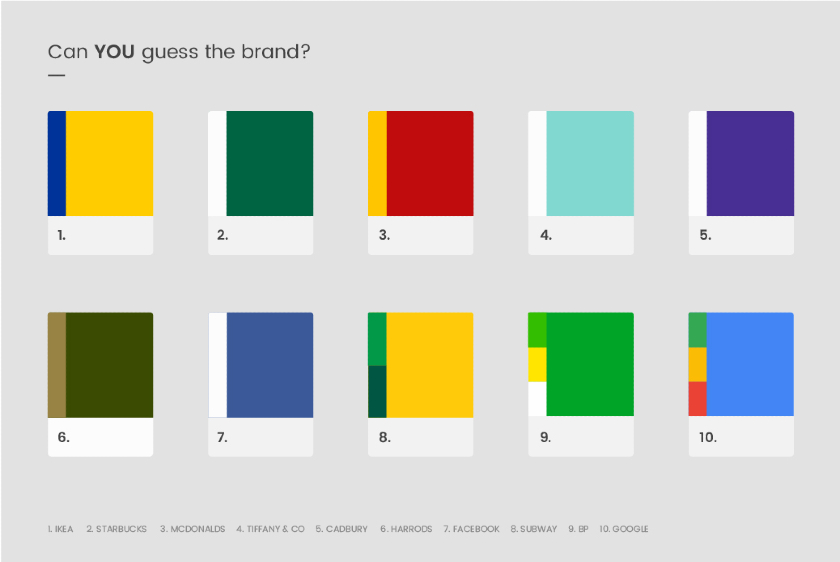
A signature color increases brand recognition by 80%. (Source: Reboot)
Branding helps ensure you are top of mind whenever a customer or potential customer sees your logo. And some brands have even made colors synonymous with their brands (e.g., the UPS slogan “What can brown do for you?”)
Learn more about the best colors to pick for your brand and website:
- Get inspired with our list of the 25 best color palettes for websites
- Learn how to pick a website color scheme that lines up with your brand and business
9. There’s more demand for brand content than ever before
An overwhelming 85% of marketers said there was more demand for brand content than before the pandemic. This is compared to 9% who reported no change and 6% who said there was less demand for their content.
Pro tip: More demand for content can quickly cause burnout, especially for small teams. Luckily, AI is increasingly coming up with solutions to help make the content creation process easier without sacrificing quality. Learn about the eight best AI content writers for small businesses.
10. 38% of high-growth brands invested in diversity, equity & inclusion in brand messaging
Diversity and inclusion are some of the most important values customers expect from brands in 2023 and beyond, and this is reflected in their purchasing habits. Brand statistics from Deloitte show that 38% of high-growth brands (those with annual revenue growth of 10% or more) invested in diversity, equity, and inclusion (DE&I) in brand messaging and imagery.
Investing in DE&I means using more inclusive language in brand communications and broadening their brand demographic to cover people of diverse backgrounds.
11. You have 7 seconds to make a first impression
Human beings scan their environment and form instant impressions. It takes just seven seconds for customers to make an instant decision about whether or not they like and trust your brand. This brand stat shows that you need to make those seven seconds count by investing in quality branding, especially visual branding, which accounts for a good deal of first impressions.
Pro tip: Based on the branding stats above, it’s important that you leverage the best sites for logo design for a logo that will help you establish a strong brand presence.
Brand Customer Statistics
Your customers are the beginning and end points of your entire branding journey. From the first building blocks of your brand identity—your mission, vision, and values—to today’s consumer trends, every step of your branding should always have your customer as its focal point. Here are some brand customer statistics to help you out:
12. 73% of consumers enjoy nostalgia branding
Everyone has a good memory of “the good old days.” That’s why nostalgia branding and marketing is one of today’s most popular strategies for brands, from the recent Clueless-inspired Super Bowl Rakuten ad to Burger King’s 1970s-inspired logo rebrand. It’s an effective one too: Research finds that 73% of consumers enjoy things that make them recall bygone times.
Nostalgia marketing increased even further during the pandemic, as many people sought comfort from earlier, less uncertain times, and it still remains a popular marketing strategy today. It does, however, require a certain balance—for nostalgia marketing to work, your subject has to be culturally significant enough that many people recognize it, but it should also bring something new.
13. 64% of customers feel emotionally connected to their favorite brands
Another reason branding is so effective is that it’s personal. Often, your brand is the personification of your business—it adds a human touch that people can connect to. In fact, some brand strategies are so effective that they foster an emotional connection: a Salesforce study found that 64% of consumers felt an emotional connection to their favorite brands.
There are some top factors that produce emotional connections between consumers and brands. Among these are when the brand aligns with personal values, is consistently interactive, and creates positive customer experiences.
14. Brand love = loyalty, word of mouth & willingness to pay more
How important is branding? You could say it’s pretty serious. Researchers studying sport-related brands (e.g., Red Bull, Nike, Adidas, and so on) found that brand love produced three significant revenue drivers: loyalty, word of mouth, and willingness to spend more. Loyalty equates to return visits and future purchases, and word of mouth produces new customers.
When consumers are willing to spend more on a brand, it gives your business more freedom to raise prices or create upgraded versions of a product. In addition, it signals to the marketplace that your business is a non-commodity, meaning your product or service can’t be replicated elsewhere.
It’s easy to understand how sports-related brands can generate brand love. After all, sports are often seen as a reflection of the inner self, and tying a brand to a team a consumer loves, by extension, brings some of the feelings along with it. The takeaway for less emotionally charged industries is that you need to find out how to connect with some aspect of your audience emotionally, from cause-related involvement to creating points of personal connection.
15. Online communities create brand trust with 64.3% of women
In studying the relationship between brand trust and online brand communities, researchers found online communities move the needle significantly in creating trust with consumers—in particular, with 64.3% of women and younger consumers (44.9% of people aged 18 to 22 years).
Still, many brands today don’t have online communities or forum websites, and some don’t even have an active social media presence for people to engage with. In addition to creating trust, developing online communities gives brands the all-so-important means of creating personal connections with customers, which in turn brings more word of mouth, loyalty, and increased brand affinity.
You can easily build an online community with a site builder like Wix. Your customers can participate in member-only content, polls, and discussions, starting with the free site builder version. See how easy it is to build a website using Wix with our video tutorial.
16. 46% of consumers will pay more for trusted brands
Software as a service (SaaS) company Salsify surveyed more than 4,000 consumers for its 2022 consumer research report. When asked to identify the factors that have driven them to buy the higher-priced option when comparing similar products online, 46% of U.S. consumers admit that they pay more for a brand name they trust.
Here’s why it pays to build brand awareness: 46% of customers tend to buy from familiar brands. The more people recognize, appreciate, and believe in your brand, the more they buy from you.
17. Shared values drive 64% of brand relationships
According to the Harvard Business Review, shared values are a driving factor in 64% of brand relationships. Your brand must resonate with the target audience’s values and convey them in a way that forms connections between your company and customers.
This branding statistic shows that every single experience and interaction counts—from the time a customer touches your brand to when they move on to other things. For instance, when it comes to technology, speed, coolness, and wow factor—that’s Apple. When you think of faith, family, great service, and tasty food—it’s Chick-fil-A.
Pro tip: Your brand’s core values are a fundamental part of your brand’s identity and how customers perceive your business. Learn what core values are and how to create them in our step-by-step guide (plus template), or check out our list of the best core values examples among other small businesses.
18. Customers will pay 50% more for businesses making an impact
Price isn’t always the bottom line. Many customers are willing to pay more to companies that align with their values. Thirteen percent of customers are willing to pay anywhere from 31% to 50% more to do business with companies they view as making a positive impact in the world. This is a noteworthy branding statistic because a lot of people assume cheaper is always more competitive, but that’s not always the case.
Customers are willing to pay more for companies that are aligned with their values.
19. 76% of consumers will stop purchasing from brands with no social responsibility
Brand responsibility is on the rise, and this is truer than ever in 2023. In fact, beyond consumers willing to pay more for brands making an impact, recent studies found that up to 76% of people will no longer purchase from brands that treat employees, communities, and the environment poorly. It isn’t enough to just include social responsibility as part of your branding—you’ll need to also walk the talk to ensure your customers’ loyalty in the years ahead.
20. For 60% of consumers, trustworthiness & transparency are the most important brand traits
All brand traits and values are important. But, according to brand trust statistics, for 60% of consumers, the most important of all would be trustworthiness and transparency to your audience. Both go hand-in-hand: Being transparent with your brand values, business decisions, and more helps build trust with your customers—which eventually fosters customer loyalty in the long run.
21. 53% of customers expect small businesses to have a brand purpose
A Razorfish study found that even small businesses are expected to have a larger purpose behind their brand. While this is a smaller number than mid-size (64%) and large companies (74%), it means that finding the purpose behind your business is an essential part of building its identity—and your success in the long run.
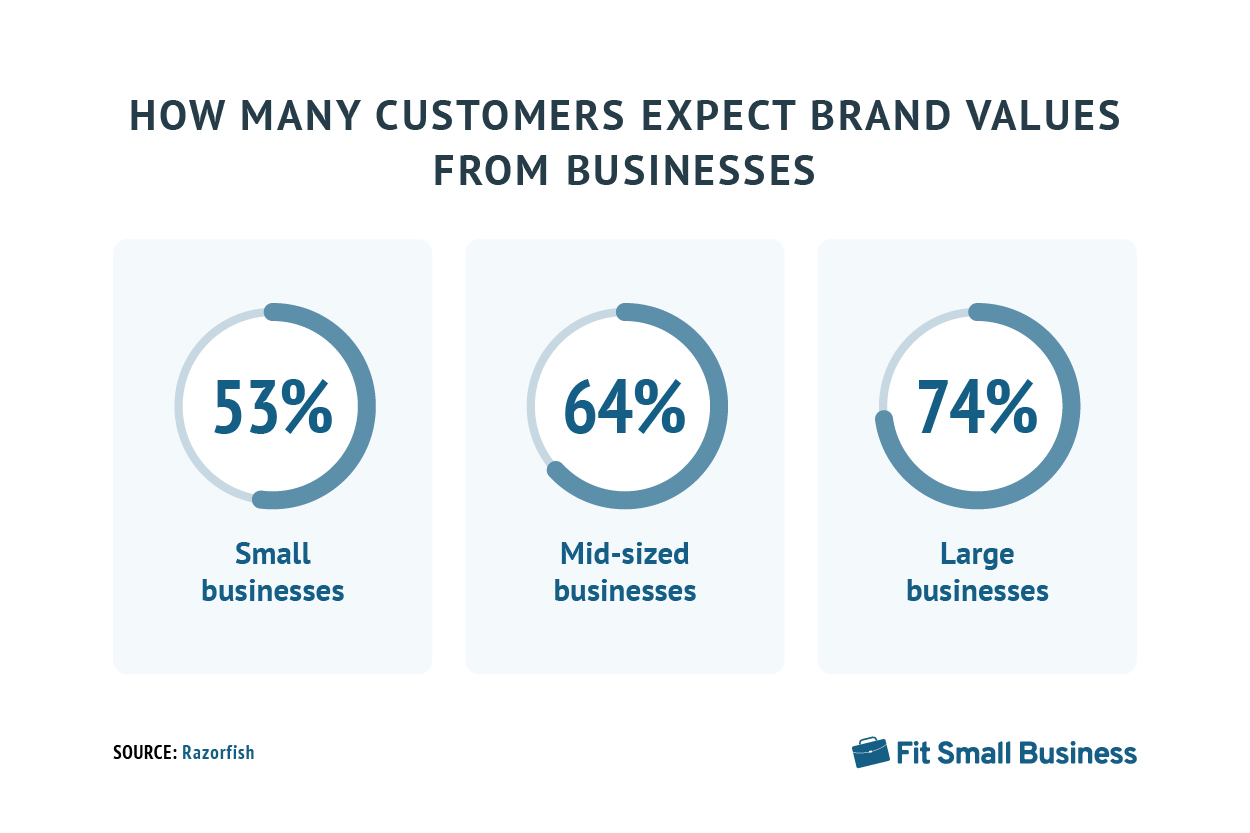
Customers expect businesses of any size to have values behind their brand.
Pro tip: Part of outlining your brand purpose is to define your mission and vision statements. Learn how to create yours today in our guides for making a mission statement and a vision statement for your business—both also have downloadable templates you can use.
22. Consumers are 32% more willing to buy from a brand with a social advocacy over one with a personal benefit
Need any more proof that brand values are more important than ever? The same study by Razorfish also found that in an experiment, consumers were 32% more willing to purchase a sample product from a brand that advocated for sustainability than from a brand that offered personal incentives at the same price point.
All this points to the steadily growing evidence that consumers expect brands to have more social responsibility now compared to previous decades.
23. 69% of consumers will engage with your brand using chatbots
Technology is expanding the number of ways customers can engage with your brand, from automation to online tools. When they come to your website, if they can’t quickly find the information they need, seven out of 10 are perfectly comfortable interacting with your brand and business via online chat, per the 2021 State of Social report from NetBase Quid.
These branding statistics clearly demonstrate that every aspect of the customer experience counts. Every touchpoint, from those within your control (like marketing materials, website, social presence—even your chatbot) to those outside of your creative process (e.g., reviews, online mentions, and so on) contribute to the perceptions that comprise your brand to the public.
Establishing brand awareness is the key to getting leads into your sales pipeline for nurturing and beginning to offer the brand consistency that produces more sales, retention, and loyalty.
24. One loyal customer is worth 10 one-time customers
Brand loyalty can be worth quite a lot. In fact, a loyal customer may be your best advocate, sharing your company’s information with many friends over time. Brand loyalty yields 10 times more than the profits you make on a single purchase.
Word of mouth is the best marketing, and it usually comes from loyal customers. This is one of the branding stats that shows that cultivating, improving, and encouraging brand loyalty provides great benefits over time.
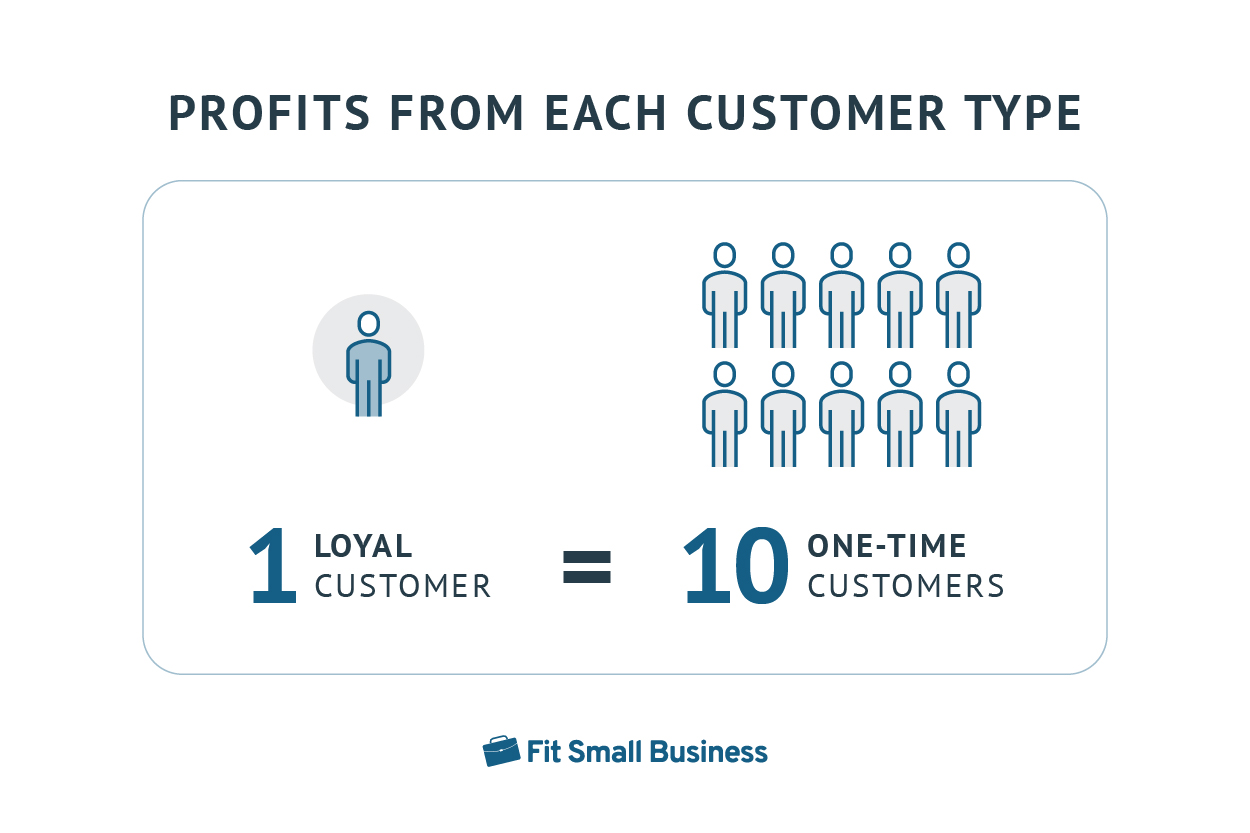
Need more proof brand loyalty pays off exponentially?
25. Most people follow 1 to 4 brands
It takes effort to win customers on social media. Fifty percent of customers only follow one to four brands on social media, with another 26% following fewer than 10 brands. Getting into the coveted spot where customers are willing to have you show up on their feed is a competitive task. Again, it’s all about relationships.
Most people usually follow fewer than five brands on social media.
Brand stats tell us customers want to feel they have a relationship with the brand. They’ll spend time with your brand, but only if you prove yourself worthy by offering content that is valuable to your customers. Brand recognition also plays a large role in bringing customers back again and again.
26. 40% of customers will stick to private label brands
Customers bought more private label brands than ever before in recent years. Fifty-eight percent of buyers switched to a private label brand when their preferred brand wasn’t available, and 40% of those said they would continue to buy the private label brand that they switched to.
Private label brands are perceived to have better value.
Private label brands are products manufactured by a third party and labeled with the brand of another. Many small businesses use private label brands to boost brand image and give customers a reason to shop at their stores.
These “exclusive” products rely more upon brand image than product differentiation for sales. Small business owners can benefit from the positive impression that consumers have of private labels to build their own branded products. Nearly half—48%—of those who said they’d keep buying the private label brand they switched to said that price was a driving factor.
Cost is one of the biggest factors influencing customers to stay with private label brands.
27. Great customer service wins over 86% of customers
Many small business owners complain that they can’t spend as much on branding as their larger competitors. This may be true, but it’s not always what you spend on a fancy new logo or an ad campaign that matters.
A convincing 86% of the time, a great customer experience will turn a one-time client into a loyal brand advocate (Khoros). In addition, 83% of customers feel more loyal to a brand that has resolved an issue or complaint. Another branding stat offered by Salesforce Research indicates 89% of people are likely to purchase again when their first brand experience is a positive one.
Providing exemplary customer service and insisting upon excellent customer service throughout your company, for example, costs little or nothing. However, it yields extraordinary results when it comes to positive brand impressions.
28. Customers make decisions based on customer service reviews
Customer service is a massive driving factor in customers’ decisions to buy again or not to buy again. Customers are also very likely to share their customer service experiences online, whether the experience was good or bad.
Those reviews matter: 80% of consumers say they only trust brands with 4 to 5-star ratings. Only 13% will consider doing business with a brand rated 1-2 stars. An ongoing review strategy is also important, as 85% of consumers say they only factor in reviews left during the most recent three months, and 40% don’t even consider those more than two weeks old.
The quickest way to build your brand’s reputation is through word of mouth from your customers. Learn how to get more reviews on Google and ways to leverage them to increase referrals, leads, and sales.
29. A 2% increase in customer retention can lower costs by 10%
Customer retention, or keeping customers coming back to your business, lowers costs by 10% because you spend less on acquisition advertising. The better your brand, the more recognition your business receives, and the easier it is to keep it top of mind among your customers.
Better branding leads to improved recognition and sales and, in turn, reduces the amount of money you must spend on advertising. It’s a virtuous cycle that starts with creating a great customer experience and welcomes customers with consistent values, products, and services.
30. 62% of customers share deals with friends
Social media is an incredibly effective venue for word-of-mouth sharing about brands. Running deals on social media and asking customers to share your offer is an effective way to generate word-of-mouth buzz and get new followers and leads online. Make the most of this and similar word-of-mouth branding stats by offering deals and giveaways that require customers to like and share to get the deal.
31. Personalized ads are preferred by 48% of customers
Many consumers, especially younger ones, have accepted that their data is going to get sold at the price of being online. As long as their information is getting collected and sold anyway, nearly half say they want companies to personalize the way they advertise to them, targeting their individual interests and lifestyles and bringing them products that will make their lives better.
Still, this is easier said than done. The Bynder State of Branding report revealed that brand marketers sometimes face challenges in marketing and advertising content, citing these top brand marketing challenges:
- 25.7%: Creating personalized messages for the right audience
- 23%: Getting the right technology in place to support personalization
- 21.8%: Finding the right balance between personalization and brand voice
Beyond these brand marketing statistics, it’s important to remember your audience doesn’t want to be bombarded with ads, especially for subjects they find irrelevant. They want ads placed in the right place, time, and channel, with the products they want to see, in ways that are useful, entertaining, and educational—not annoying.
The best way to personalize your sales and marketing messages is to use a customer relationship management (CRM) platform like HubSpot CRM. It will collect and organize your data, send timely emails, and put your ads in front of prospects at just the right moment. Learn more about HubSpot or find the right CRM for your business in our list of the best CRMs for small businesses.
Branding Strategy Statistics
Branding isn’t complete without a brand strategy to guide your efforts to grow your brand awareness. Social media, influencer marketing, and content marketing are some of the most popular strategies today to increase your brand presence, and many brand awareness statistics speak to their effectiveness. Keep reading more branding statistics on strategy.
32. Increasing brand awareness is a top priority
Semrush asked 1,500 marketers from over 40 countries to indicate their top priorities in creating brand content from most important (1) to least important (8). In the State of Content Marketing survey, 45% of respondents ranked “increase brand awareness” as the number one priority, giving it top billing among the objectives listed.
Brand awareness is the key to driving customers to your business and fostering loyalty. Creating a recognizable brand can help you attract new customers and grow your business. It can also make your brand more memorable and differentiate it from your competitors. Start by creating a strong visual identity for your brand and then consistently apply this branding across all of your marketing materials.
33. It takes 5 to 7 impressions to produce brand awareness
Customers won’t remember a brand after just seeing it a couple of times. Branding data shows that people have to be exposed to a brand five to seven times to start recognizing it. It takes further consistent exposure over time for the brand to become familiar enough and remembered by name. This is why commercials and ads are so important. Even if people do not buy because they saw one specific commercial, they are being exposed to the brand.
34. Automation is changing the face of branding
There is a new shift in acceptance of the use of automation for marketing—including branding and creatives. According to a survey by Bynder, OnBrand, and Vanson Bourne, around half of the 1,600 marketers surveyed in 2021 said creative automation would help them meet output production goals since it can be used to create content more efficiently.
The same survey also indicates that more marketers are now recognizing the benefits of using automation for branding. Around 50% of respondents said that automation would actually improve brand consistency in 2021.
35. 99% of marketers believe automation can help businesses with branding
In the age of generative artificial intelligence (AI), an overwhelming 99% of marketers believed that automations could soon help businesses with their creative and branding efforts, according to the same 2021 survey. This was a significant increase from the previous year, where only 77% believed in using automations for branding.
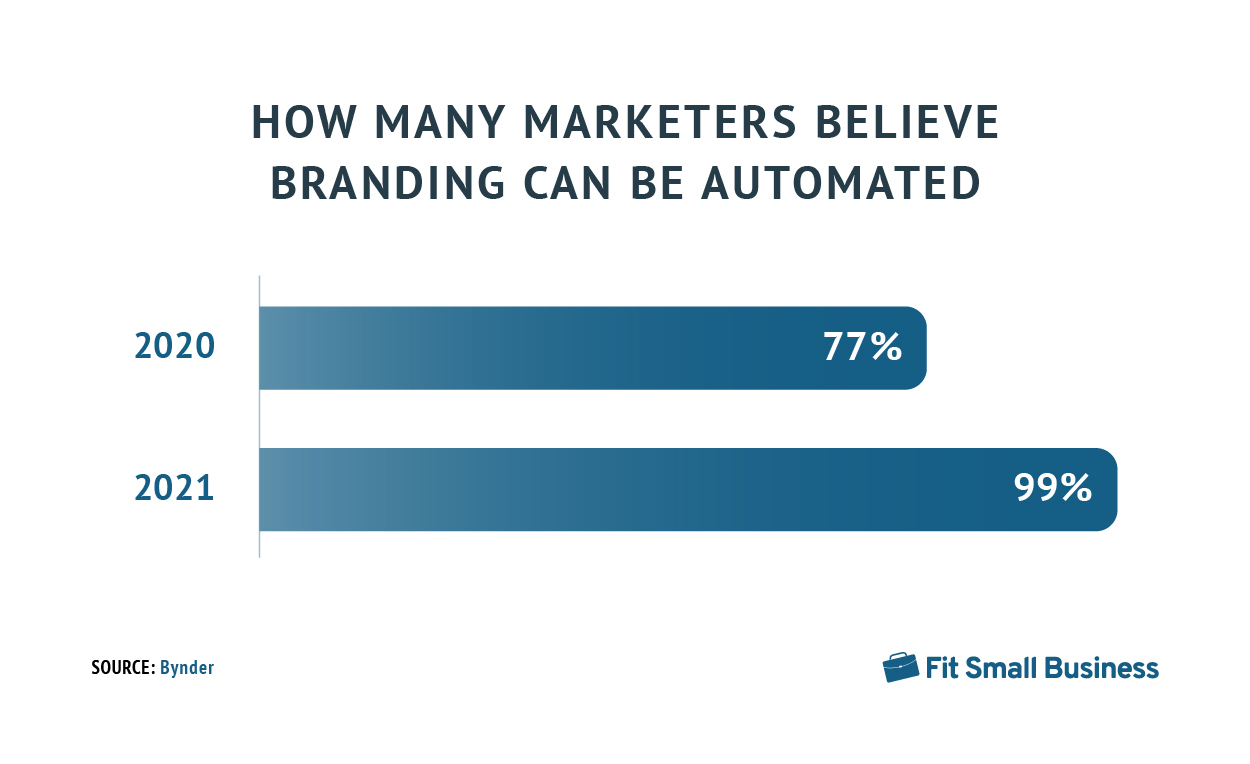
More marketers increasingly believe in automations for branding.
36. Social media is the top driver of consumer brand sentiment
A 2022 study measuring the effect of digital marketing on consumer behavior found that the top three drivers of consumer attitudes to be (in order):
- Social media
- Search engine advertising
- Content marketing
However, in terms of purchase intent, the study found that content marketing had the most impact, followed by social media, search ads, and email marketing. It’s interesting to note the study found that email marketing didn’t contribute significantly to either consumer attitudes or search intent.
One takeaway here is search ads are significantly contributing to brand sentiment. So, developing search and banner ads that closely align with your brand’s desired image and unique value proposition is essential. Second, content marketing becomes more important during the consumer’s consideration phase in deciding which brand to go with.
37. 32% of businesses use influencers mainly for brand awareness
MeltWater’s 2021 State of Social found that at 32%, both business-to-business (B2B) and business-to-consumer (B2C) brands listed increasing brand awareness as their top goal for influencer marketing. For non-government organizations (NGOs), increasing brand awareness was also the top goal listed by 35% of marketers.
Meanwhile, branding statistics from the study show that influencer marketing is an increasingly popular tool for brand awareness in general, with 41% stating they would use it by the end of the year.

Businesses of all types use influencers for brand awareness.
38. Content marketing drives 3x higher brand engagement
Content marketing gets three times as many leads as advertising. It encourages brand engagement, leading to brand awareness, recognition, and recall. Investing in quality content, especially personalized content, connects people to your brand’s voice and builds relationships. It costs less than pay-per-click ads, and it gets customers to trust your brand by providing useful information about topics that interest your audience.
39. Overdoing self-promotion will cost you followers
Per the Unfollow Algorithm on Buzzfeed, 45% of customers will unfollow a brand on social media if it spends too much time promoting itself. Remember that, for the most part, people are tuned into one station: “WIIFM” (an acronym that stands for “What’s in it for me?”).
Spending too much time promoting your company could prompt customers to unfollow you. (Source: BuzzStream)
Branding statistics from a study conducted by Twitter and Market Probe International found that 72% of customers who follow a company on Twitter are likely to buy from that company. Instead of only promoting your products, offer information and engagement that will help your customers within your niche. Focus on making their lives better, and you will gain loyalty.
Create a customer persona, or an ideal customer, and think about how your brand solves problems for that ideal customer. Then, target your social media marketing efforts around that narrative, and you’ll build a winning formula. Curious about what a customer persona is all about? Read this article on how to create a customer persona and download a free template.
40. Influencer marketing was the top strategy for increasing brand recognition in 2022
In 2022, marketers were leveraging influencer marketing (34%) more than any other tactic, in part to counteract the diminishing impact of online ads due to the increased use of ad blockers. This is followed by improving the site visitor experience on mobile (33%), short-form videos (31%), virtual events (31%), and experiential marketing (29%) to build brand recognition and promote sales.
The 2022 State of Marketing Trends (by HubSpot, Litmus, Rock Content, and Wistia) report also showed the top channels being employed are:
- 44%: Social media
- 36%: Website/blog
- 35%: Email marketing
- 32%: Content marketing
- 30%: Influencer marketing
- 26%: SEO marketing
- 25%: Virtual events
41. 80% use social ads to increase brand recognition
Only 20% of brand marketers don’t use social ads to increase brand awareness and recognition. For the eight in 10 using paid social, Facebook produces the highest return on investment (ROI) for 26% of marketers, followed by Instagram, YouTube, Twitter, and the new kid on the social media bloc, TikTok.
The top social platforms being used for advertising in 2022 were:
- 79%: Facebook
- 69%: YouTube
- 65%: TikTok
- 63%: Instagram
- 57%: Twitter
- 56%: Tumblr
- 49%: Reddit
- 47%: LinkedIn
- 43%: Twitch
- 42%: Pinterest
- 41%: Snapchat
42. 36% of brands want employee word of mouth
Who better to endorse a brand than its employees? Thirty-six percent of B2B companies are or plan to encourage online employee advocacy to build a stronger brand reputation. The same is true for 21% of direct-to-consumer businesses and 18% of non-government organizations (Meltwater State of Social Media 2021).
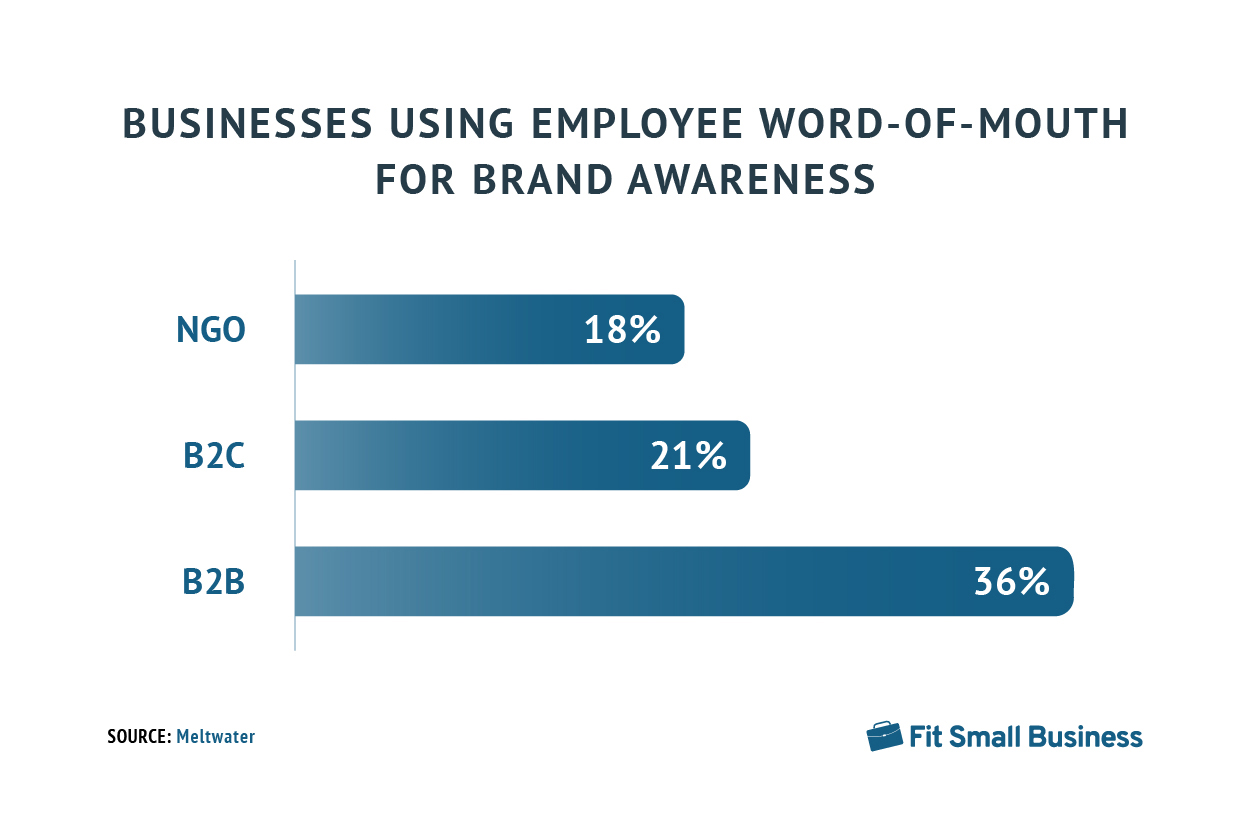
B2B businesses use word-of-mouth marketing the most.
Social media, of course, is another highly effective way to build your brand, which is why your branding strategy should also carry over to any social media channels your business chooses to use. When building a brand on social media, it is important to consider the following:
43. 73% of marketers think social media marketing is effective
Today, customers expect to be able to engage with brands instantly, especially on social media. Customers also look to social media to see how companies handle customer service and whether they are responsive to customer feedback. Social media users share deals and reviews with each other.
Sixty-eight percent of adults use Facebook, making it the most-used social media platform. And 73% of marketers believe that social media is either somewhat effective or very effective for their business. These branding statistics show just how important it is to invest in a winning social media strategy.
Struggling to see a return on social media? Leaving it to the experts could be the answer. Read our guide on the best social media agencies for small businesses to find an affordable and effective option.
44. Effective use of social media can increase sales by 32%
Stores with a social media presence make an average of 32% more sales than stores that aren’t on social channels. From engaging posts to real-time customer service (which makes you look trustworthy to potential customers), your Facebook, Twitter, and Instagram accounts can all help your business win customers and generate more revenue.
For example, nearly eight out of 10—78% of U.S. consumers—have purchased from a brand they discovered on Facebook. For more information on how social media can boost your small business, check out our guide to social media marketing.
45. Choosing the right platform matters
Few marketers are unaware that some social media platforms are better for building brand recognition and awareness with their target audiences than others. Fifty-five percent of business-to-business (B2B) marketers turn to LinkedIn compared to just 28% that leverage Facebook for brand building, per MeltWater’s 2021 State of Social report.
On the other hand, Facebook is far and away the go-to social channel for building brand awareness for business-to-consumer (B2C) companies, followed by Instagram, Twitter, and LinkedIn.
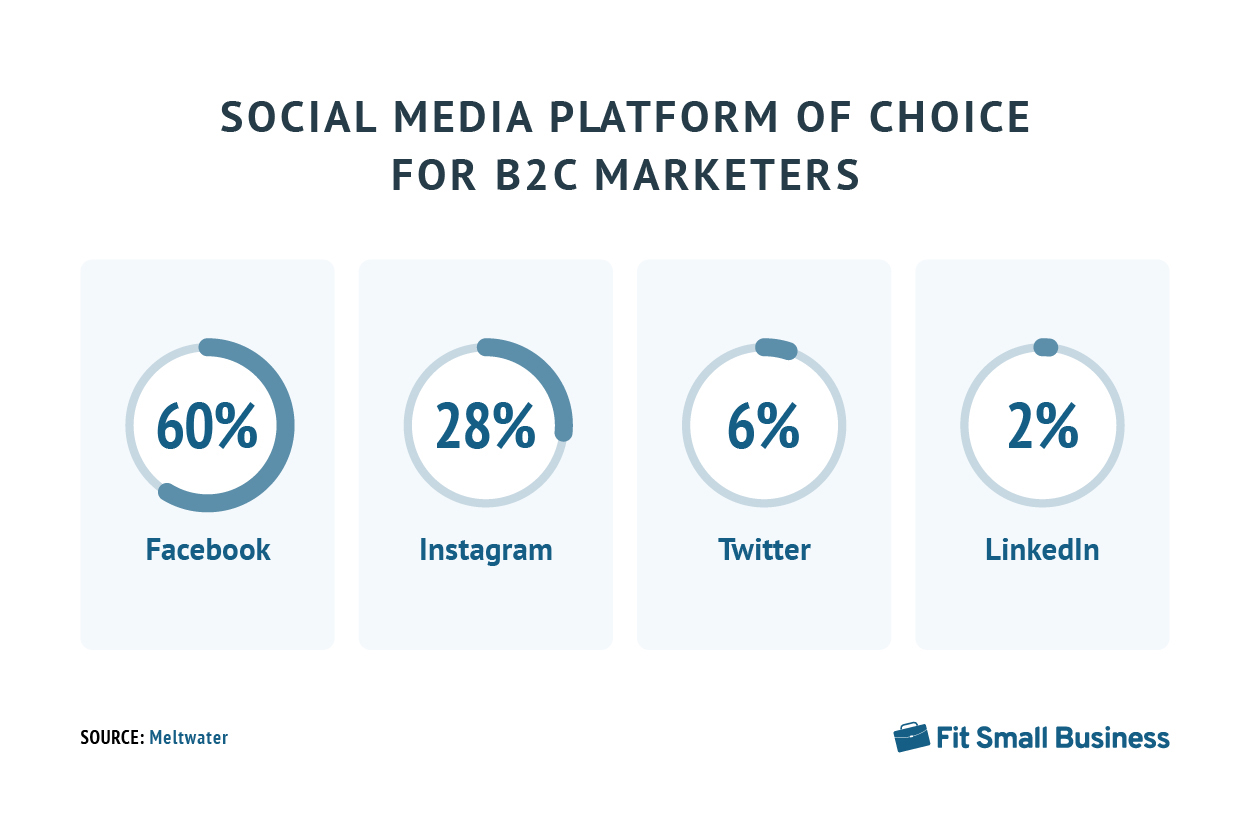
Facebook remains the leading marketing platform for B2C.
Frequently Asked Questions
As mentioned above, branding stats show that branding consistency can increase revenue by 10% to 20%. The simple reason for this is the more customers experience a consistent experience with your brand, the more familiar they become, which in turn increases trustworthiness and brand loyalty, eventually leading to more sales.
While there are no set codas for branding, some principles that branding experts agree on are defining your unique brand identity—including your voice and visuals, finding your target community or audience, outlining your brand values, and being consistent in maintaining your branding across all campaigns and channels. Other helpful branding principles include being authentic with your brand and finding your brand’s USP (unique selling proposition).
Brand awareness is important because it is the topmost level of the marketing funnel, and, therefore, the first part of the customer journey. Brand awareness is the stage where audiences first become acquainted with your brand. It’s essentially their first impression of your business and determines whether or not they want to know more and eventually become paying customers.
Bottom Line
A strong brand with wide recognition can be worth millions, if not billions, of dollars. A recognizable brand image, consistently deployed across all marketing channels, helps increase brand awareness. With the insights from these branding statistics, you can build a great brand that helps you retain more customers and reduce marketing costs.